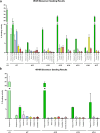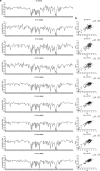Essential tremor with tau pathology features seeds indistinguishable in conformation from Alzheimer's disease and primary age-related tauopathy
- PMID: 39775287
- PMCID: PMC11711841
- DOI: 10.1007/s00401-024-02843-6
Essential tremor with tau pathology features seeds indistinguishable in conformation from Alzheimer's disease and primary age-related tauopathy
Abstract
Neurodegenerative tauopathies are characterized by the deposition of distinct fibrillar tau assemblies, whose rigid core structures correlate with defined neuropathological phenotypes. Essential tremor (ET) is a progressive neurological disorder that, in some cases, is associated with cognitive impairment and tau accumulation. In this study, we explored tau assembly conformation in ET patients with tau pathology using cytometry-based tau biosensor assays. These assays quantify the tau seeding activity present in brain homogenates by detecting the conversion of intracellular tau-fluorescent protein fusions from a soluble to an aggregated state. Pathogenic tau assemblies exhibit seeding barriers, where a specific assembly structure cannot serve as a template for a native monomer if the amino acid sequences are incompatible. We recently leveraged this species barrier to define tauopathies systematically by substituting alanine (Ala) into the tau monomer and measuring its incorporation into seeded aggregates within biosensor cells. This Ala scan precisely classified the conformation of tau seeds from various tauopathies. In this study, we analyzed 18 ET patient brains with tau pathology, detecting robust tau seeding activity in 9 (50%) of the cases, predominantly localized to the temporal pole and temporal cortex. We further examined 8 of these ET cases using the Ala scan and found that the amino acid requirements for tau monomer incorporation into aggregates seeded from ET brain homogenates were identical to those of Alzheimer's disease (AD) and primary age-related tauopathy (PART), and distinct from other tauopathies, such as corticobasal degeneration (CBD), chronic traumatic encephalopathy (CTE), and progressive supranuclear palsy (PSP). These findings indicate that in a pathologically confined subset of ET cases with significant tau pathology, tau assembly cores are identical to those seen in AD and PART. This could facilitate more precise diagnosis and targeted therapies for ET patients presenting with cognitive impairment.
Keywords: Alanine scan; Alzheimer’s disease; Essential tremor; PART; Tau.
© 2025. The Author(s).
Conflict of interest statement
Declarations. Conflict of interest: The authors declare no competing interests.
Figures






Update of
-
Essential tremor with tau pathology features seeds indistinguishable in conformation from Alzheimer's disease and primary age-related tauopathy.bioRxiv [Preprint]. 2024 Oct 20:2024.10.12.617973. doi: 10.1101/2024.10.12.617973. bioRxiv. 2024. Update in: Acta Neuropathol. 2025 Jan 8;149(1):6. doi: 10.1007/s00401-024-02843-6. PMID: 39464029 Free PMC article. Updated. Preprint.
Similar articles
-
Essential tremor with tau pathology features seeds indistinguishable in conformation from Alzheimer's disease and primary age-related tauopathy.bioRxiv [Preprint]. 2024 Oct 20:2024.10.12.617973. doi: 10.1101/2024.10.12.617973. bioRxiv. 2024. Update in: Acta Neuropathol. 2025 Jan 8;149(1):6. doi: 10.1007/s00401-024-02843-6. PMID: 39464029 Free PMC article. Updated. Preprint.
-
Secernin-1 is a novel phosphorylated tau binding protein that accumulates in Alzheimer's disease and not in other tauopathies.Acta Neuropathol Commun. 2019 Dec 3;7(1):195. doi: 10.1186/s40478-019-0848-6. Acta Neuropathol Commun. 2019. PMID: 31796108 Free PMC article.
-
Distinct involvement of the cranial and spinal nerves in progressive supranuclear palsy.Brain. 2024 Apr 4;147(4):1399-1411. doi: 10.1093/brain/awad381. Brain. 2024. PMID: 37972275 Free PMC article.
-
CSF tau and the CSF tau/ABeta ratio for the diagnosis of Alzheimer's disease dementia and other dementias in people with mild cognitive impairment (MCI).Cochrane Database Syst Rev. 2017 Mar 22;3(3):CD010803. doi: 10.1002/14651858.CD010803.pub2. Cochrane Database Syst Rev. 2017. PMID: 28328043 Free PMC article.
-
In vivo tau PET imaging in dementia: Pathophysiology, radiotracer quantification, and a systematic review of clinical findings.Ageing Res Rev. 2017 Jul;36:50-63. doi: 10.1016/j.arr.2017.03.002. Epub 2017 Mar 15. Ageing Res Rev. 2017. PMID: 28315409
References
-
- Louis ED, Martuscello RT, Gionco JT, Hartstone WG, Musacchio JB, Portenti M et al (2023) Histopathology of the cerebellar cortex in essential tremor and other neurodegenerative motor disorders: comparative analysis of 320 brains. Acta Neuropathol 145:265–283. 10.1007/s00401-022-02535-z - PMC - PubMed
-
- Louis ED (2023) Essential tremor. Handb Clin Neurol 196:389–401. 10.1016/B978-0-323-98817-9.00012-0 - PubMed
Publication types
MeSH terms
Substances
Grants and funding
LinkOut - more resources
Full Text Sources
Medical
Miscellaneous

